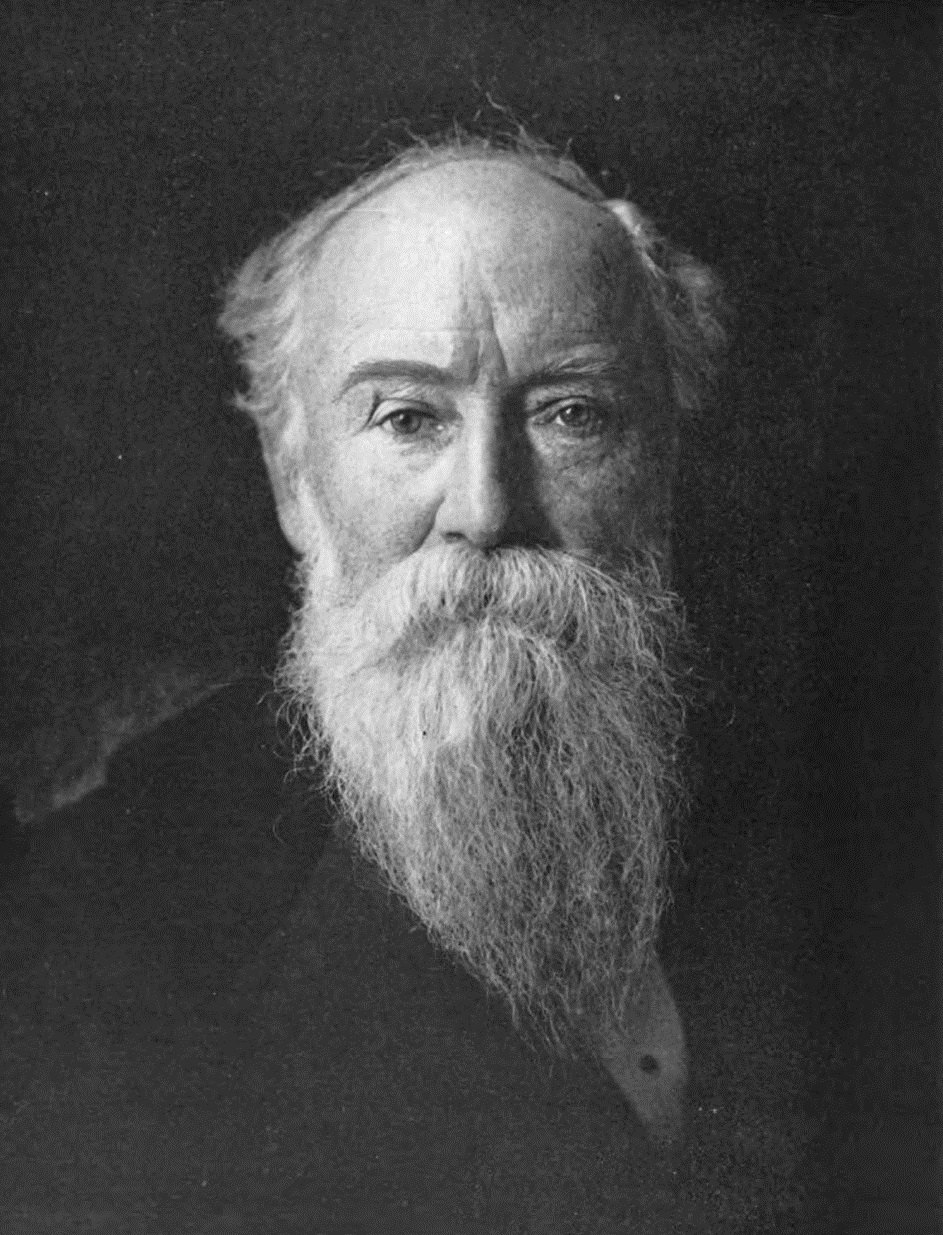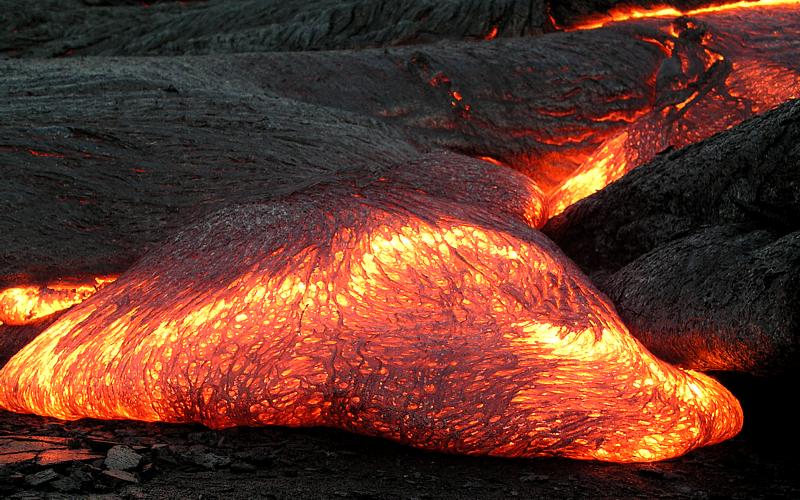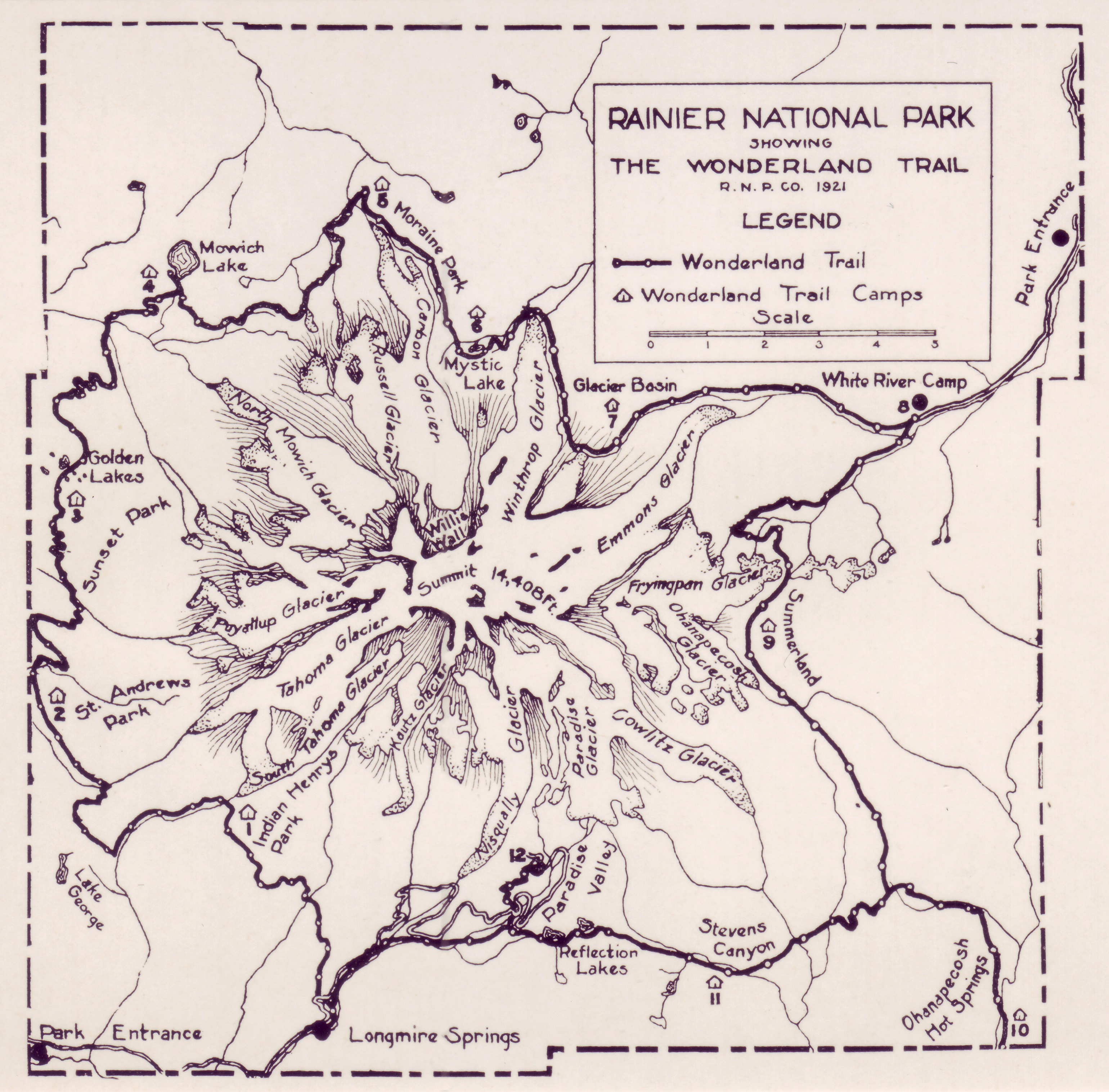|
Burroughs Mountain
Burroughs Mountain is located on the northeast slope of Mount Rainier above Glacier Basin. It was named for John Burroughs, the naturalist, who visited the mountain several times. The mountain was first called John Burroughs Mountain. Burroughs was born near Roxbury, New York, in April 1837, and died in 1931. He wrote extensively about his travels and was associated with the conservation movement. He became a well known "character" and is best remembered for his "Nature Essay." Burroughs Mountain is a high ridge formed from an ancient lava flow. Its three summit plateaus get progressively higher. The mountain, located within Mount Rainier National Park, is notable for alpine tundra, with plants typically seen at much higher latitudes. The tundra ground cover hugs the barren rocky plateau and has a short growing season because snow covers the ridge for much of the year in the harsh alpine climate. The unique fragile alpine tundra can be easily destroyed by people walking off ... [...More Info...] [...Related Items...] OR: [Wikipedia] [Google] [Baidu] |
John Burroughs
John Burroughs (April 3, 1837 – March 29, 1921) was an American naturalist and nature essayist, active in the conservation movement in the United States. The first of his essay collections was ''Wake-Robin'' in 1871. In the words of his biographer Edward Renehan, Burroughs' special identity was less that of a scientific naturalist than that of "a literary naturalist with a duty to record his own unique perceptions of the natural world." The result was a body of work whose resonance with the tone of its cultural moment explains both its popularity at that time, and its relative obscurity since. Early life and marriage Burroughs was the seventh of Chauncy and Amy Kelly Burroughs' ten children. He was born on the family farm in the Catskill Mountains, near Roxbury in Delaware County, New York. As a child he spent many hours on the slopes of Old Clump Mountain, looking off to the east and the higher peaks of the Catskills, especially Slide Mountain, which he would later write ... [...More Info...] [...Related Items...] OR: [Wikipedia] [Google] [Baidu] |
Hiking
Hiking is a long, vigorous walk, usually on trails or footpaths in the countryside. Walking for pleasure developed in Europe during the eighteenth century.AMATO, JOSEPH A. "Mind over Foot: Romantic Walking and Rambling." In ''On Foot: A History of Walking'', 101-24. NYU Press, 2004. Accessed March 1, 2021. http://www.jstor.org/stable/j.ctt9qg056.7. Religious pilgrimages have existed much longer but they involve walking long distances for a spiritual purpose associated with specific religions. "Hiking" is the preferred term in Canada and the United States; the term " walking" is used in these regions for shorter, particularly urban walks. In the United Kingdom and the Republic of Ireland, the word "walking" describes all forms of walking, whether it is a walk in the park or backpacking in the Alps. The word hiking is also often used in the UK, along with rambling , hillwalking, and fell walking (a term mostly used for hillwalking in northern England). The term bushwalking i ... [...More Info...] [...Related Items...] OR: [Wikipedia] [Google] [Baidu] |
Cyperaceae
The Cyperaceae are a family of graminoid (grass-like), monocotyledonous flowering plants known as sedges. The family is large, with some 5,500 known species described in about 90 genera, the largest being the "true sedges" genus '' Carex'' with over 2,000 species. These species are widely distributed, with the centers of diversity for the group occurring in tropical Asia and tropical South America. While sedges may be found growing in almost all environments, many are associated with wetlands, or with poor soils. Ecological communities dominated by sedges are known as sedgelands or sedge meadows. Some species superficially resemble the closely related rushes and the more distantly related grasses. Features distinguishing members of the sedge family from grasses or rushes are stems with triangular cross-sections (with occasional exceptions, a notable example being the tule which has a round cross-section) and leaves that are spirally arranged in three ranks. In comparison ... [...More Info...] [...Related Items...] OR: [Wikipedia] [Google] [Baidu] |
Journal Of Volcanology And Geothermal Research
''Journal of Volcanology and Geothermal Research'' is a scientific journal that publishes recent research on the fields of volcanology and geothermal activity, as well as the societal and environmental impact of these phenomenon. Abstracting and indexing This journal is abstracted and indexed by the following services: * Chemical Abstracts * Current Contents * Engineering Index * GEOBASE * Mineralogical Abstracts * Scopus * GeoRef * Science Citation Index * Referativnyi Zhurnal See also * List of scientific journals * List of scientific journals in earth and atmospheric sciences A ''list'' is any set of items in a row. List or lists may also refer to: People * List (surname) Organizations * List College, an undergraduate division of the Jewish Theological Seminary of America * SC Germania List, German rugby unio ... References Volcanology Geophysics journals Elsevier academic journals Geology journals {{geology-journal-stub ... [...More Info...] [...Related Items...] OR: [Wikipedia] [Google] [Baidu] |
Magma
Magma () is the molten or semi-molten natural material from which all igneous rocks are formed. Magma is found beneath the surface of the Earth, and evidence of magmatism has also been discovered on other terrestrial planets and some natural satellites. Besides molten rock, magma may also contain suspended crystals and gas bubbles. Magma is produced by melting of the mantle or the crust in various tectonic settings, which on Earth include subduction zones, continental rift zones, mid-ocean ridges and hotspots. Mantle and crustal melts migrate upwards through the crust where they are thought to be stored in magma chambers or trans-crustal crystal-rich mush zones. During magma's storage in the crust, its composition may be modified by fractional crystallization, contamination with crustal melts, magma mixing, and degassing. Following its ascent through the crust, magma may feed a volcano and be extruded as lava, or it may solidify underground to form an intrusion, su ... [...More Info...] [...Related Items...] OR: [Wikipedia] [Google] [Baidu] |
Andesite
Andesite () is a volcanic rock of intermediate composition. In a general sense, it is the intermediate type between silica-poor basalt and silica-rich rhyolite. It is fine-grained (aphanitic) to porphyritic in texture, and is composed predominantly of sodium-rich plagioclase plus pyroxene or hornblende. Andesite is the extrusive equivalent of plutonic diorite. Characteristic of subduction zones, andesite represents the dominant rock type in island arcs. The average composition of the continental crust is andesitic. Along with basalts, andesites are a component of the Geology of Mars, Martian crust. The name ''andesite'' is derived from the Andes mountain range, where this rock type is found in abundance. It was first applied by Christian Leopold von Buch in 1826. Description Andesite is an aphanitic (fine-grained) igneous rock that is intermediate in its content of silica and low in alkali metals. It has less than 20% quartz and 10% feldspathoid by volume, with at least 6 ... [...More Info...] [...Related Items...] OR: [Wikipedia] [Google] [Baidu] |
Phenocryst
300px, Swiss side of the Mont Blanc massif, has large white plagioclase phenocrysts, triclinic minerals that give trapezoid shapes when cut through). 1 euro coins, 1 euro coin (diameter 2.3 cm) for scale. A phenocryst is an early forming, relatively large and usually conspicuous crystal distinctly larger than the grains of the rock groundmass of an igneous rock. Such rocks that have a distinct difference in the size of the crystals are called porphyries, and the adjective porphyritic is used to describe them. Phenocrysts often have euhedral forms, either due to early growth within a magma, or by post-emplacement recrystallization. Normally the term ''phenocryst'' is not used unless the crystals are directly observable, which is sometimes stated as greater than .5 millimeter in diameter. Phenocrysts below this level, but still larger than the groundmass crystals, are termed ''microphenocrysts''. Very large phenocrysts are termed '' megaphenocrysts''. Some rocks contain both ... [...More Info...] [...Related Items...] OR: [Wikipedia] [Google] [Baidu] |
Wonderland Trail
The Wonderland Trail is an approximately hiking trail that circumnavigates Mount Rainier in Mount Rainier National Park, Washington, United States. The trail goes over many ridges of Mount Rainier for a cumulative of elevation gain. The trail was built in 1915. In 1981, it was designated a National Recreation Trail. An estimated 200 to 250 people a year complete the entire trail with several thousand others doing shorter sections of it. The average time taken to complete the entire trip is 10 to 14 days. The route The trail is entirely within the national park and passes through major life zones of the park, from lowland forests to subalpine meadows of wildflowers. As the trail circles the mountain, hikers see different faces of Mount Rainier, carved by 25 named glaciers. The trail is considered strenuous as it is almost always climbing or descending the ridges around the mountain. The highest point is at Panhandle Gap. There are many river crossings on the trail incl ... [...More Info...] [...Related Items...] OR: [Wikipedia] [Google] [Baidu] |
Sunrise Historic District
The Sunrise Historic District, also known as the community of Sunrise, Washington, is located at approximately on a ridge overlooking the northeast side of Mount Rainier in Mount Rainier National Park. The district comprises seven individual structures designed in accordance with the principles of the National Park Service Rustic style. The area is inhabited and open to the public only during a brief period in the summer season. Planning The area was originally known as Yakima Park, and became accessible with the construction of a new road in the northeastern portion of the park, planned by Ernest A. Davidson of the National Park Service Landscape Division and the Bureau of Public Roads. Davidson prepared a master plan for Yakima Park, by way of contrast to development in the southern portion of the park at Paradise and Longmire, where haphazard development had become a significant management problem. Davidson's plan included a large hotel supporting a community of housek ... [...More Info...] [...Related Items...] OR: [Wikipedia] [Google] [Baidu] |
Tree Line
The tree line is the edge of the habitat at which trees are capable of growing. It is found at high elevations and high latitudes. Beyond the tree line, trees cannot tolerate the environmental conditions (usually cold temperatures, extreme snowpack, or associated lack of available moisture). The tree line is sometimes distinguished from a lower timberline, which is the line below which trees form a forest with a closed Canopy (biology), canopy. At the tree line, tree growth is often sparse, stunted, and deformed by wind and cold. This is sometimes known as ''krummholz'' (German for "crooked wood"). The tree line often appears well-defined, but it can be a more gradual transition. Trees grow shorter and often at lower densities as they approach the tree line, above which they are unable to grow at all. Given a certain latitude, the tree line is approximately 300 to 1000 meters below the permanent snow line and roughly parallel to it. Causes Due to their vertical structure, tree ... [...More Info...] [...Related Items...] OR: [Wikipedia] [Google] [Baidu] |
Little Tahoma Peak
Little Tahoma Peak, also called Little Tahoma, is a satellite peak of Mount Rainier in Pierce County, Washington and in Mount Rainier National Park. It is quite noticeable from Seattle over away. Little Tahoma Peak is a volcanic remnant. It was part of a larger Mount Rainier which has eroded. The rock is quite unstable and in 1963 a large avalanche originating below it covered the lower section of Emmons Glacier with rock debris. The Fryingpan Glacier and Whitman Glacier are located just to the east of the peak. Little Tahoma Peak can most easily be accessed from Summerland, an alpine meadow area in Mount Rainier National Park Mount Rainier National Park is an American national park located in southeast Pierce County and northeast Lewis County in Washington state. The park was established on March 2, 1899, as the fourth national park in the United States, preservin .... The first recorded ascent was on August 29, 1894, by JB Flett and Henry H. Garrison who climbe ... [...More Info...] [...Related Items...] OR: [Wikipedia] [Google] [Baidu] |
Fryingpan Glacier
Fryingpan Glacier is on the eastern face of the Little Tahoma Peak, just to the east of Mount Rainier in the U.S. state of Washington. The glacier is located on top of a cliff from the Emmons Glacier to the north and a small ridge separates this glacier from the Whitman Glacier to the south, except for a small snowfield in which these two glaciers are connected. Most of the ice is located on a broad plateau at an elevation of . The head of the Fryingpan Glacier is located to the northeast of the ridge and at the foothill of Little Tahoma Peak at around . The glacier flows downhill eastward and the uneven topography causes the glacier surface to be crevassed The glacier ends on shallow to steep slopes at about . Numerous snowfields and alpine meadows are located near the bottom and east of the glacier. Meltwater from the glacier drains into the White River. See also *List of glaciers in the United States This is a list of glaciers existing in the United States, currently or ... [...More Info...] [...Related Items...] OR: [Wikipedia] [Google] [Baidu] |







